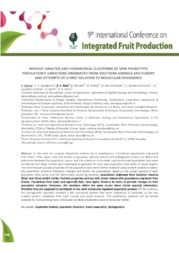Wavelet analysis and hierarchical clustering of ofm phenotypic population's variations originated from southern america and europe and attempts of a first relation to molecular divergence.
Wavelet analysis and hierarchical clustering of ofm phenotypic population's variations originated from southern america and europe and attempts of a first relation to molecular divergence.
Author(s): DAMOS, P.; BONSIGNORE, C. P.; NAVA, D. E.; BERNARDI, D.; BOTTON, M.; BARROS-PARADA, W.; FUENTES-CONTRERAS, E.; ESCUDERO-COLOMAR, L. A.; BOSCH, D.; AVTZIS, D. N.
Summary: In this work we compare Grapholita molesta Busck (Lepidoptera: Tortricidae) populations originated from Brazil, Chile, Spain, Italy and Greece using power spectral density and phylogenetic analysis to detect any similarities between the population macro- and the molecular micro-level. Log-transformed population data were normalized and AR(p) models were developed to generate for each case population time series of equal lengths. The time-frequency/scale properties of the population data were further analyzed using wavelet analysis to detect any population dynamics frequency changes and cluster the populations. Based on the power spectral of each population time series and the hierarchical clustering schemes, populations originated from Southern America (Brazil and Chile) exhibit similar rhythmic properties and are both closer related with populations originated from Greece. Populations from Spain and especially Italy, have higher distance by terms of periodic changes on their population dynamics. Moreover, the members within the same cluster share similar spectral information, therefore they are supposed to participate in the same temporally regulated population process. On the contrary, the phylogenetic approach revealed a less structured pattern that bears indications of panmixia, as the two clusters contain individuals from both Europe and South America. This preliminary outcome will be further assessed by incorporating more individuals and likely employed a second molecular marker.
Publication year: 2016
Types of publication: Abstract in annals or event proceedings
Unit: Embrapa Grape & Wine
Observation
Some of Embrapa's publications are published as ePub files. To read them, use or download one of the following free software options to your computer or mobile device. Android: Google Play Books; IOS: iBooks; Windows and Linux: Calibre.
Access other publications
Access the Agricultural Research Database (BDPA) to consult Embrapa's full library collection and records.
Visit Embrapa Bookstore to purchase books and other publications sold by Embrapa.

